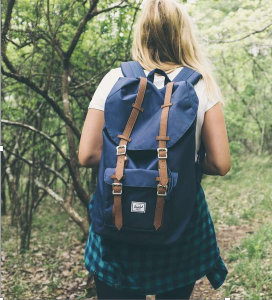By Alison Doyle
Lawnstarter, Austin
 We’ve all heard the old Boy Scouts’ adage that it’s important we leave nature a little better than we found it. When we hike, we don’t litter, we stay on designated trails, we walk out with everything we went in with, and we are mindful of animal habitats. And that includes not spraying chemicals in their space.
We’ve all heard the old Boy Scouts’ adage that it’s important we leave nature a little better than we found it. When we hike, we don’t litter, we stay on designated trails, we walk out with everything we went in with, and we are mindful of animal habitats. And that includes not spraying chemicals in their space.
Let’s talk about some eco-friendly alternatives to ensure your hike is bug-free.
Choose non-chemical repellents
Citronella, eucalyptus, and lemongrass oils are effective alternatives to chemical repellents. The scents—particularly citronella –work by masking natural body odors that attract mosquitoes and other insects. This makes it difficult for the insects to locate you.
To avoid skin irritation, it’s best to apply these oils to clothing as opposed to directly to your skin. If you want to apply the oils to your skin for greater coverage, it is recommended that you mix the pure oil with a carrier, such as an unscented lotion. It’s also important to consider how these oils may interact with sun exposure.
Wear protective clothing
Depending on the hike you have planned, you’re probably already prepared to wear long pants and long sleeves, but insect-repellent clothing provides even better protection. The CDC recommends wearing light colors so that ticks are easier to spot. Also, loose clothing makes it harder for bugs to bite you.
For bug protection specifically, consider permethrin-treated garments. Permethrin is a synthetic insecticide derived from chrysanthemum flowers which can provide long-lasting protection against mosquitoes, ticks, and other insects. Many clothing items treated with permethrin also provide SPF protection and are made from moisture-wicking materials. **
Plan your hike wisely
If you can avoid times of peak bug activity, this is a great way to further protect yourself from irksome bites. Insects are most active at dawn and dusk, so plan your hikes accordingly. You can also opt for times and locations where there is more wind since bugs are less active in windy conditions.
Utilizing well-maintained trails is another great way to avoid bugs. Mosquitoes and other bugs breed in standing water and dense vegetation, so designated hiking trails may see less bug activity since such elements are scarce in these areas. It’s also important to stay on designated trails so as not to disturb insect (and other animal) habitats.
Whether you’re headed out to your favorite trail or mapping out a new adventure, proper preparation is key for an enjoyable and safe hiking experience. It doesn’t matter if your focus is on a healthier lifestyle or lower-impact outdoor adventuring – avoiding harsh chemicals is an important first step in enjoying the outdoors bug-free.
 Alison is a world traveler who loves to spend her time writing and reading. When she’s home, you can find her playing with her pet rabbit and baking.
Alison is a world traveler who loves to spend her time writing and reading. When she’s home, you can find her playing with her pet rabbit and baking.
** Editor’s note: According to the EPA, “All exposure scenarios showed that permethrin factory-treated clothing is unlikely to pose any significant immediate or long-term hazard to people wearing the clothing. The amount of permethrin allowed in clothing is very low, and scientific studies indicate that human exposure resulting from wearing permethrin factory-treated clothing is also low. Available data show that permethrin is poorly absorbed through the skin.”
